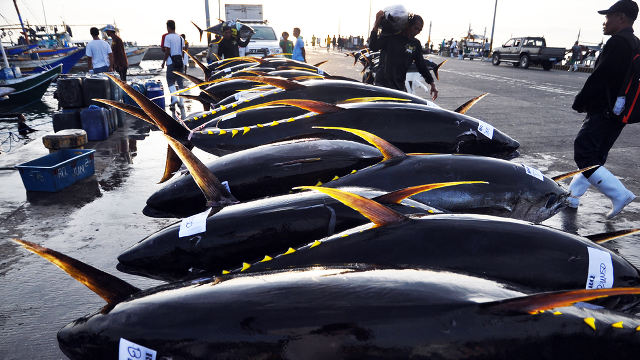SUMMARY
This is AI generated summarization, which may have errors. For context, always refer to the full article.

GENERAL SANTOS, Philippines – Total tuna and other fish landings at the General Santos City Fishport Complex went up by 11.31% for the first 5 months this year over the same period in 2013, according to the figures released by the Philippine Fisheries Development Authority.
It is the 3rd consecutive year since 2011 that total volume of fish landings in the city has registered an annual increase.
Records show that the total fish volume landed at the fishport complex from January to May this year already reached 42,897.56 metric tons (MT) compared to only 33,363.83 MT in the first 5 months of 2013.
Volume of production also increased in 2012, from 112,890.81 MT in 2011 to 139,613.34 MT that year.
Registering the biggest increase this year is Market 3 with 16,765.57 MT of tuna landings or an increase of 5,045.82 MT from last year’s January to May volume of 11,719.75 MT.
The landings at Market 4 represented a hefty 30% increase in volume.
Market stalls
The General Santos City fish port has 4 market complexes.
Market 3 is where big tuna purse seine operators – a type of net fishing method – land their catch of skipjacks and other similar tuna species. Big yellowfin tunas are unloaded at Market 1.
This year’s yellowfin tuna landings at Market 1 also posted a slight increase at 4,513.08 MT over last year’s 4,470.59 MT.
Also spiking their tuna catches are small and medium purse seine operators as well as municipal fishermen who landed a total of 21,618.91 MT of tuna and other fish species at Market 2. The figure is 18.16% higher over the total volume of 11,719.91 MT over the same period in 2013.
Foreign and local frozen tuna landings likewise posted a slight increase at 43,877.15 MT from 43,075.88 last year.
Overall tuna landings and fish production posted a sharp drop in 2011 with only 112,890.81 total landings, down from 143,139.18 MT in 2010 or a decrease of 30,425.50 MT.
Market 4 is not operational at the moment.
Declining stocks
Philippine fisheries officials and tuna industry players blamed the 2011 decline in tuna landings to conservation measures imposed by the Western and Central Pacific Fisheries Commission (WCPFC) after global alarms were raised in 2005 over notable depletion of tuna stocks. (READ: PH oceans in crisis: The sad state of small fisherfolk)
The WCPFC, of which the Philippines is a signatory and a member, blamed overfishing and the changing weather pattern in the drop in tuna catches worldwide.
Among the measures imposed by WCPFC is the 3-month annual ban on Fish Aggregating Device (FAD) fishing in the region starting in 2009 and the closure of Pocket 1 High Seas to purse seine fishing in the beginning of 2010. (READ: Want to feed the world? Save oceans first)
In 2012, however, the Philippines was granted an exemption to operate 38 purse seine fishing vessels in the tuna-rich international waters but limited the capacity of catcher boats to 50 tons.
Tragedy
Two months after Pocket 1 High Seas was open to Filipino fishermen, tragedy struck as Typhoon Pablo (international name Bopha) hit the country in December of that year.
Hours after Pablo hit landmass, the Philippine press reported 378 tuna fishermen missing after they were caught in the path of the super typhoon.
It is now considered the biggest single tragedy to hit the Philippine fishing industry.
Bureau of Fisheries and Aquatic Resources (BFAR) director Asis Perez earlier attributed the increase of tuna landings to the success of conservation measures adopted by the Philippine government.
As part of the conservation measures, the Philippine government also imposed a 3-month ban on sardine fishing off Basilan Straits and Sulu Sea said to be vital spawning grounds of yellowfin tunas.
“Pelagic species like tuna are highly-migratory predators and they follow the food chain. Sardines are one of them,” Perez explained.
Had Pablo not struck, Philippine tuna production could have gone higher as more than 50 fishing vessels, 5 of them catcher boats, were lost in the typhoon.
Still tuna capital
Meanwhile, General Santos City Mayor Ronnel Rivera dismissed claims that Mindoro is now the tuna capital in the country.
Several reports, one citing the World Wildlife Forum, earlier said Mindoro has emerged as the new tuna capital of the Philippines following “significant increase” in tuna catches over the past years.
BFAR earlier said Mindoro recorded annual tuna catches of 600,000 kilos in 2011 and 2012.
Rivera said that that is only 600 tons.
“That is way off our figures,” the city mayor said.
The Riveras are the largest tuna company in General Santos City with operations stretching to as far Micronesia and Solomon Islands.
Its flagship company, the RD Fishing, operates a canning and processing plant in Papua New Guinea.
Fresh yellowfin tuna exporter John Heitz confirmed some big yellowfin which landed in Mindoro are being flown to General Santos due to the attractive price of the city’s renowned sashimi-grade tunas.
“But some of these tunas eventually suffer in quality due to over-handling,” Heitz explained.
At its height, General Santos City was exporting an average of more than 10 tons of fresh yellowfin tunas to the American and Japanese markets.
General Santos city currently produces between 30 to 35 tons of yellowfin tuna daily. But less than 20% end up in the export market. – Rappler.com
Add a comment
How does this make you feel?
There are no comments yet. Add your comment to start the conversation.